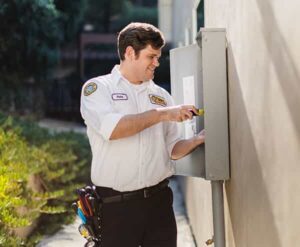What To Do When Lightning Strikes Your Rental Property
If you’ve never had it happen, you might think lightning striking a building is one of those “Hollywood” disasters—loud, dramatic, but rare. But when it is your rental property that gets hit? It’s less about special effects and more about stress, phone calls, and wondering if your insurance will come through in time.
Step One: Make Sure Everyone’s Safe
In the chaos, it’s easy to forget. If the strike caused a fire or smoke, you or your tenants need to get out—now. Even if there’s no visible damage, you don’t want to be inside a structure where the wiring might be live in weird ways.
One of my friends had a lightning strike on his rental property last summer. It wasn’t a direct hit—more like a power surge through the wiring—but it still fried appliances and left a faint burning smell. The tenants stayed put because they didn’t see flames, which, in hindsight, was risky.
Step Two: Call the Fire Department (Even If It Looks Fine)
Here’s the thing: lightning can cause “hidden” fires inside walls, attic spaces, or behind electrical panels. You may not see or smell anything immediately. A quick inspection by the fire department can catch smoldering insulation before it turns into a full-blown blaze.
And yes, it can feel awkward calling them when there’s no obvious smoke pouring out of your rental property—but it’s better than being the one on the news the next day explaining why your house burned down overnight.
Step Three: Shut Off the Power
If it’s safe to do so, cut the power at the main breaker. Lightning strikes can travel through the electrical system, damaging wiring, outlets, and appliances. Leaving it energized could cause further damage or spark a fire.
I’ve seen cases where a strike blew out every light bulb in the house, tripped all the breakers, and still managed to damage the HVAC system. Turning off the power right away helps prevent secondary problems.
Step Four: Document Everything
Before you start cleaning up or making repairs, take photos and videos. Lots of them. Insurance claims for a rental property often hinge on proof, and lightning damage can be weirdly inconsistent—one outlet might be fried while the one next to it is fine.
Get images of the exterior (especially the roof or siding if there’s visible scorching), the electrical panel, damaged electronics, and any scorch marks.
Step Five: Call Your Insurance Company Immediately
Lightning damage is usually covered under most landlord insurance policies, but you need to report it promptly. The faster you start the claims process, the sooner you can get repairs done and your rental property back to normal.
If you’re not sure what’s covered—like temporary housing for your tenants—ask directly. I’ve seen landlords assume coverage for something like tenant relocation, only to find out they needed a specific endorsement.
Step Six: Get a Professional Inspection
Even if things “look okay,” bring in an electrician to inspect the wiring, outlets, and major systems. Lightning can create small pinholes in wiring insulation that lead to shorts weeks or months later.
You’ll also want to check the HVAC, water heater, and any other systems connected to power. A rental property isn’t just a house—it’s a business investment. Hidden electrical issues could become a liability down the road.
Step Seven: Communicate with Your Tenants
It’s easy to focus on logistics and forget that tenants might be shaken up by the experience. Keep them informed about timelines for inspections, repairs, and (if necessary) temporary relocation.
And here’s a pro tip from experience—if you’re doing repairs, try to schedule them all at once rather than piecemeal. Nothing frustrates tenants more than feeling like they’re living in a never-ending repair zone.
Step Eight: Prevent Future Strikes (As Much As Possible)
You can’t control the weather, but you can reduce the risk. Consider:
What To Do When Lightning Strikes Your Rental Property
- Lightning rods – These provide a path to safely ground a strike.
- Whole-house surge protectors – Protect wiring and connected devices.
- Grounding upgrades – Ensure your Rental Property meets current electrical grounding standards.
A relatively small investment in prevention can save you thousands later.
The Cost of Doing Nothing
Here’s the reality: ignoring potential lightning damage can be expensive. That “probably fine” wiring could cause a fire months later. That half-working HVAC could fail in the middle of winter. And the worst part? You might not connect it back to the lightning strike, which can make getting coverage harder.
One landlord I know decided not to replace a slightly damaged electrical panel after a strike. A year later, a tenant reported smelling burning plastic. Turns out the panel had been slowly overheating the whole time. The replacement ended up costing double because of the additional damage.
Final Thoughts
If lightning strikes your rental property, don’t treat it like a one-and-done event. The visible damage is only part of the story. Safety checks, professional inspections, and solid communication with your tenants can keep a bad day from becoming a full-on disaster.
At the end of the day, your property is more than bricks and wiring—it’s your investment and someone’s home. Handle it with urgency, document thoroughly, and you’ll be in a much better position to protect both.
